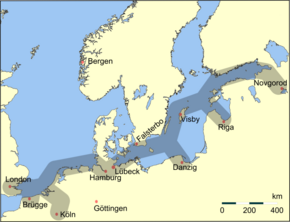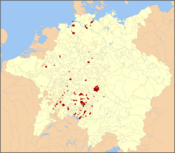Bremen
| Bremen | |
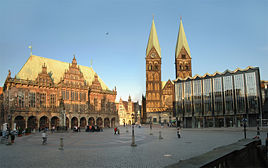 |
|
| Coat of arms | Location |
 |
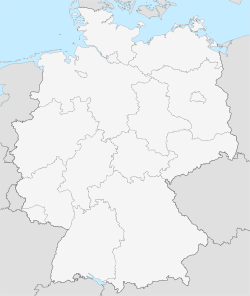 |
| Administration | |
| Country | Germany |
|---|---|
| State | Bremen |
| District | Urban district |
| City subdivisions | 5 boroughs with 23 districts |
| First mayor | Jens Böhrnsen (SPD) |
| Governing parties | SPD / Greens |
| Basic statistics | |
| Area | 326.73 km² (126.2 sq mi) |
| Elevation | 12 m (39 ft) |
| Population | 548,477 (31/10/2006) |
| - Density | 1,679 /km² (4,348 /sq mi) |
| - Metro | 1,511,198 |
| Other information | |
| Time zone | CET/CEST (UTC+1/+2) |
| Licence plate | HB |
| Postal codes | 28001–28779 |
| Area code | 0421 |
| Website | bremen.de |
Bremen (IPA: [ˈbʁeːmən]) is a Hanseatic city in northwestern Germany (official name: Stadtgemeinde Bremen / City Municipality of Bremen). It is a port city, situated along the river Weser, about 60 km (37 mi) south from its mouth on the North Sea. Bremen is one of two towns belonging to the state of Bremen (official name: Freie Hansestadt Bremen1 (Free Hanseatic City of Bremen), referring to its membership in the medieval Hanseatic League), the other being Bremerhaven. In 2005, the population of the city was estimated to be 545,983 (the state with the city Bremerhaven having a population of 664,080), while the metropolitan area of Bremen-Oldenburg has a population of more than 2.37 million. Thus, Bremen is the second most populous city in North Germany and tenth in Germany.
Contents |
History


Map of Central Europe from 919-1125, by William R. Shepherd
|
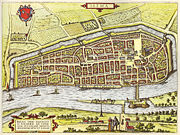
1600 Bremen
|
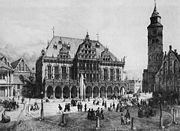
1859 Marketplace of Bremen
|
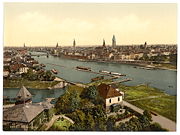
1900 Bremen
|
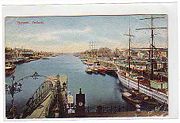
1911 Ports of Bremen
|
In 150 AD the geographer Claudius Ptolemaeus described Fabiranum or Phabiranum, known today as Bremen. In that time the Chauci lived in the area which is now call northwestern Germany or Lower Saxony. By the end of the 3rd century, they had merged with the Saxons. During the Saxon Wars (772-804) the Saxons, led by Widukind, fought against the West Germanic Franks, the founders of the Carolingian Empire and lost the war.
Charlemagne, the King of the Franks, made a new law, the Lex Saxonum. This law stated that Saxons were not allowed to worship Odin (the god of the Saxons), but rather that they had to convert to Christianity on pain of death. This period was called the Christianisation. In 787 Willehad of Bremen was the first Bishop of Bremen. In 848 the diocese of Hamburg merged with the diocese of Bremen, and in the following centuries the bishops of Bremen were the driving force behind the Christianisation of north Germany. In 888 gained Archbishop Rimbert, Kaiser Arnulf of Carinthia, the Carolingian King of East Francia, and the market, coin and customs law.
The first stone city walls were built in 1032. Around this time trade with Norway, England and the northern Netherlands began to grow, increasing the importance of the city.
-
- "…Rome equal to a well-known and rallying the peoples of the North…"
In 1186 Holy Roman Emperor Frederick I Barbarossa became the first secular ruler of Bremen. From this time forward, only the emperor and the Senate Governmental authority have ruled Bremen. Bremen was formally a Free Imperial City. In fact, however, Bremen did not have complete independence from the Archbishops, in that there was no freedom of religion, and citizens were still forced to pay church taxes. Shortly following Bremen's secularization, in 1260, came its admission to the Hanseatic League.
In 1350 population hit 20,000 citizens. During this time period the Hansekogge (cog ship) became a specialty of Bremen.
In 1620 Germany's first man-made harbour was built at Vegesack.
The Linz Diploma, written in 1646 by Ferdinand III, is a document issued during the Thirty Years' War that confirmed and sealed the imperial immediacy of the city of Bremen.
In 1811 Napoleon invaded Bremen and integrated it as the capital of the Departement de Bouches du Weser (Department of the Mouths of Weser) in the French State. 1815 hosted the last battle of the Liberation War of Germany, the Battle of Waterloo, in which the armies of Prussia, Austria, Russia and England, defeated the army of Napoleon, resulting in Bremen's sovereignty.
The first German steamship manufactured in 1817 at the yard of Johann Lange.
Bremen bought land from the Kingdom of Hannover in 1827, founding of the city of Bremerhaven (Port of Bremen) as an outpost of Bremen because of the increased silt buildup in the Weser river.
Beck's (Brauerei Beck & Co KG), a brewery, was founded in 1837 and remains in operation today. The shipping company The North German Lloyd (NDL) was founded in 1857. The Lloyd was a synonym for commercial shipping and is now a part of Hapag-Lloyd. In 1872 the Bremer Cotton Exchange was created. Focke-Wulf Flugzeugbau AG was founded in 1923, and is today part of Airbus, a manufacturer of civil and military aircraft. Borgward, an automobile manufacturer, was founded in 1929, and is today part of Daimler AG.
Following the Bombing of Bremen in World War II, Bremen was captured by the British 3rd Infantry Division in late April 1945. After World War II, the city became a part of the American occupation zone as the USA wanted to have a port under its control. Bremen's mayor traveled to the US to seek Bremen's independence from Lower Saxony, as Bremen had traditionally been a city-state.
In 1947 Nordmende was founded, a manufacturer of entertainment electronics. In 1958 OHB-System was founded, a manufacturer of medium-sized spaceflight satellites.
Population history
- 1350: 20,000
- 1810: 35,800 inhabitants
- 1830: 43,700
- 1850: 55,100
- 1880: 111,900
- 1900: 161,200
- 1925: 295,000
- 1969: 607,185
- 1998: 550,0004
- 2006: 546,900
Politics

The Stadtbürgerschaft (municipal assembly) is made up of 68 of the 83 legislators of the state legislature, the Bremische Bürgerschaft, who reside in the city of Bremen. The legislature is elected by the citizens of Bremen every four years.[1]
One of the two mayors (Bürgermeister) is elected President of the Senate (Präsident des Senats) and serves as head of the city and the state. The current President is Jens Böhrnsen.
Main sights


|
View from the Bremen Cathedral in the direction of the Stephani-Bridge
|
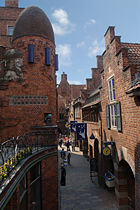
Böttcherstraße
|
- Many of the sights in Bremen are found in the Altstadt (Old Town), an oval area surrounded by the Weser River, on the southwest, and the Wallgraben, the former moats of the medieval city walls, on the northeast. The oldest part of the Altstadt is the southeast half, starting with the Marktplatz and ending at the Schnoor quarter.
- The Marktplatz (Market square) is dominated by the opulent façade of the Town Hall. The building was erected between 1405 and 1410 in Gothic style, but the façade was built two centuries later (1609–12) in Renaissance style. Today, it hosts a restaurant in original decor with gigantic wine barrels, the Ratskeller in Bremen, and the wine lists boasts more than 600 — exclusively German — wines. It is also home of the twelve oldest wines in the world, stored in their original barrels in the Apostel chamber.
- Two statues stand to the west side of the Town Hall: one is the statue (1404) of the city's protector, Roland, with his view against the Cathedral and bearing Durendart, the "sword of justice" and a shield decorated with an imperial eagle. The other near the entrance to the Ratskeller is Gerhard Marcks's bronze sculpture (1953) Die Stadtmusikanten (Town Musicians) which portrays the donkey, dog, cat and rooster of the Grimm Brothers' fairy tale.
- Other interesting buildings in the vicinity of the Marktplatz are the Schütting, a 16th-century Flemish-inspired guild hall, and the Stadtwaage, the former weigh house (built in 1588), with an ornate Renaissance façade. The façades and houses surrounding the market square were the first buildings in Bremen to be restored after World War II, by the citizens of Bremen themselves.
- The impressive Cathedral St. Petri (13th century), to the east of the Marktplatz, with sculptures of Moses and David, Peter and Paul, Charlemagne and Christopher Maki.
- The Liebfrauenkirche (Our Lady's Church) is the oldest church of the town (11th century). Its crypt features several impressive murals from the 14th century.
- Off the south side of the Markplatz, the 110-metre (120 yards) Böttcherstraße was transformed in 1923–1931 by the coffee magnate Ludwig Roselius, who commissioned local artists to convert the narrow street (in medieval time, the street of the barrel makers) into an inspired mixture of Gothic and Art Nouveau. It was considered "entartete Kunst" (depraved art) by the Nazis. Today, the street is one of Bremen's most popular attractions.
- At the end of Böttcherstraße, by the Weser bank, stands the Martinikirche (St Martin's Church), a Gothic brick church built in 1229, and rebuilt in 1960 after its destruction in World War II.
- Tucked away between the Cathedral and the river is the Schnoor, a small, well-preserved area of crooked lanes, fishermen's and shipper's houses from the 17th and 18th centuries, now occupied by cafés, artisan shops and art galleries.
- Schlachte, the medieval harbour of Bremen (the modern port is some kilometres downstream) and today a riverside boulevard with pubs and bars aligned on one side and the banks of Weser on the other.
More contemporary tourist attractions include:
- Universum Science Center, a modern science museum
- Botanika, an extension to a public rhododendron park that attempts be to the same as the Universum, but for biology
- Beck's Brewery, tours are available to the public which include beer tasting
- The Kunsthalle Bremen, an art museum with paintings from the 19th and 20th century, maintained by the citizens of Bremen
Structures
- Mediumwave transmitter Bremen
- Fallturm Bremen
- Bremen-Walle Telecommunication Tower
The Freie Waldorfschule in Bremen-Sebaldsbrück was Germany's first school built to the Passivhaus low-energy building standard.[2]
Transport
|
Airport Bremen
|

Main train station Bremen
|
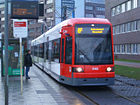
Tram
|
Bremen has an international airport situated in the south of the city.
Bremer Straßenbahn AG (translates from German as Bremen Tramways Corporation), often abbreviated BSAG, is the public transport provider for Bremen, offering tramway and bus services.
Industries
Several high-tech industries have settled in the city. Many of Germany's space technology exports are manufactured in EADS Astrium facilities in Bremen, such as the Columbus module of the International Space Station, Europe's Ariane 5 rocket upper stages and the Automated Transfer Vehicle. The telematics, space technology and satellite company OHB-System is also based in the city. Furthermore, Bremen is the home of the second biggest Airbus plant of Germany, producing wing equipment for the A300/A310, A330/A340 and A380 families of aircraft. There is also a Mercedes-Benz factory in Bremen, building the C, CLK, SL, and SLK series of cars. Beginning in 2008, the GLK sport utility vehicle will also be built in Bremen. Beck's and St Pauli Girl beers are brewed in Bremen. It also had a huge number of wine importers, but the number is down to a precious few. Apart from that there is another link between Bremen and wine: about 800 years ago, quality wines were produced here. A large number of food producing or trading companies are located in Bremen with their German or European headquarters: Inbev (Beck's Brewery), Kellogg's, Kraft Foods (Kraft, Jacobs Coffee, Milka Chocolate, Milram, Miràcoli), Frosta (frosted food), Nordsee (chain of sea fast food), Melitta Kaffee, Eduscho Kaffee, Azul Kaffee, Vitakraft (pet food for birds), Atlanta AG (Chiquita banana), chocolatier Hachez (fine chocolate and confiserie), feodora chocolatier6.
Events
- Every year since 1036, in the last two weeks of October, Bremen has hosted Freimarkt ("Free market"), one of the world's oldest and in Germany one of today's biggest continuously celebrated fairground festivals.
- Bremen is also host to one of the four big annual Techno parades, the Vision Parade.
- Every year the city plays host to young musicians from across the world, playing in the International Youth Symphony Orchestra of Bremen (IYSOB).
- Bremen was host to the 2006 RoboCup competition.
- Bremen will host the 2009 International Mathematical Olympiad (IMO).
Sports
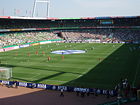
The Weserstadion (Football (soccer) stadium)
|
|
The AWD-Dome
|
It is home of the football team SV Werder Bremen which won the German Football Championship for the fourth time and the German Football Cup for the fifth time in 2004, making SV Werder Bremen just the fourth team in German football history to win the double.
Education
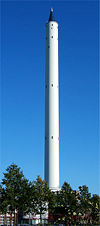
The University of Bremen is the largest university in Bremen5. Furthermore Bremen has a University of the Arts and the University of Applied Sciences, more recently the Jacobs University Bremen.
Miscellaneous
- Bremen is the birthplace of violinist Georg Kulenkampff, entertainer Hans-Joachim Kulenkampff, actors Ben Becker and Meret Becker, singer, songwriter (current Band: Element of Crime), and novelist Sven Regener, James Last, President Karl Carstens (term 1979–1984) and others.
- In December 1949, Bremen hosted the lecture cycle "Einblick in das, was ist" by the philosopher Martin Heidegger, in which Heidegger introduced his concept of a "fourfold" of earth and sky, gods and mortals. This was also Heidegger's first public speaking engagement following his removal from his Freiburg professorship by the Denazification authorities.
- Bremen is connected with a fairy tale by the Brothers Grimm, the Town Musicians of Bremen, although they never actually reach Bremen in the tale.
- The 1922 film Nosferatu, eine Symphonie des Grauens was set mostly in Bremen.
- A fictional mask in the Nintendo-made video game The Legend of Zelda: Majora's Mask, is named the Bremen's Mask.

- Local beers brewed in Bremen: Beck's, Haake-Beck, Kräusen, Hemelinger, St. Pauli Girl.
Famous people
- Adolf Bastian - polymath
- Henry Bohlen American Civil War Union Brigadier General.
- Karl Carstens - politician
- Henrich Focke - aviation pioneer and co-founder of Focke-Wulf.
- Harald Genzmer - composer of contemporary classical music
- Klaus Kleinfeld - chief executive officer (CEO) of Siemens AG
- Johann Georg Kohl - travel writer, historian and geographer
- Louis Krages - racing driver and businessman
- Hans-Joachim Kulenkampff - actor and TV host
- Murat Kurnaz - Guantanamo Bay prisoner for four years
- James Last - composer and big band leader
- Franz Adolf Eduard Lüderitz - merchant and colonist
- Joachim Neander - hymn song writer
- Wilhelm Olbers - physician and astronomer
- Ludwig Quidde - pacifist politician
- Sven Regener - musician and writer
- Gottfried Reinhold Treviranus - naturalist
- Friedrich Gerhard Rohlfs - geographer, explorer, author and adventurer
- Bert Trautmann - football goalkeeper
- Jürgen Trittin - Green politician
- Wilhelm Wagenfeld - industrial designer of the 20th Century
- Kai Warner - pop musician
- Hermann Uhde - Wagnerian baritone
Sister cities
Bremen's sister cities are:
See also
- List of Mayors of Bremen
- Werder Bremen
External links
Footnotes
References
- ↑ www.bremische-buergerschaft.de
- ↑ Passivhaus schools (German), Passivhaus Institute, accessed 2007-05-30
- Tristam Carrington-Windo, Katrin M. Kohl (1998). A Dictionary of Contemporary Germany. Routledge (UK). ISBN 1-57958-114-5. page 64
-
Claus Christian: A photographic excursion through Bremen, Bremen-North, Bremerhaven, Fischerhude and Worpswede, 2007 ISBN 978-3-00-015451-5
|
||||||||||||||||||||||||||
|
||||||||||||||||||||||||
|
|||||||||||||||||

